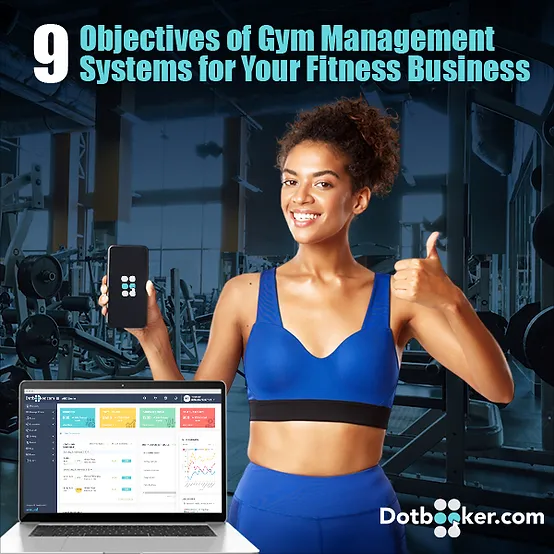
- By Dotbooker
- Sep 19, 2025
- 369
Choosing Gym Software That Supports Analytics, Hybrid Classes & Real-Time Access
Running a gym used to mean focusing on physical facilities: equipment, trainers, and membership plans.
Today, members expect more. They want their fitness journey to be measurable, flexible, and accessible in real time. That’s why choosing the right gym management software has become one of the most important decisions for gym owners.
The right platform should do three things exceptionally well: deliver analytics that drive smarter decisions, support hybrid classes that offer flexibility, and provide real-time access that makes the member experience seamless.
Analytics: Turning Data into Smarter Gym Operations
Data is no longer optional — it’s the engine behind every successful gym. Without it, owners are left guessing: Do I need more trainers in the evening? Should I cut down morning classes? Why are memberships dipping this month? With analytics built into gym software, those questions get real answers instead of assumptions.
Here’s how analytics create real impact in practice:
- Attendance patterns: Imagine your check-in reports showing that Monday evenings are always packed while Friday mornings are nearly empty. Instead of sticking to a fixed timetable, analytics help you adapt—adding an extra Monday spin class or scaling down quiet slots. The result? Happier members who find available classes when they want them, and better use of your trainers’ time.
- Class performance: Numbers tell you which programs truly resonate. If data reveals that HIIT classes are consistently booked out but yoga sessions rarely cross 50% capacity, you don’t just know attendance—you know where to reinvest your energy. Swap underperforming slots with trending workouts, and you’ll see engagement rise without increasing costs.
- Revenue tracking: Gyms often juggle multiple income streams—memberships, day passes, personal training, and retail sales. Analytics reveal which stream is generating the most revenue and which one requires a boost. For example, if personal training contributes 30% of income but retail only 5%, it’s a clear signal to refine your product strategy.
- Retention indicators: One of the biggest silent challenges is losing members without warning. Analytics can flag members who haven’t checked in for two weeks, giving staff the chance to reach out with reminders, discounts, or personal encouragement. Instead of losing them, you get a second chance to keep them on track.
The real difference is this: instead of running a gym on instinct, you run it like a data-driven business. That means better decisions, stronger member engagement, and a clear path to profitability.

Hybrid Classes: Delivering Fitness Without Boundaries
The way people approach fitness has shifted permanently. Members no longer see value in being tied only to a building; they want the freedom to work out on their own terms. The right gym membership software allows you to extend your gym’s walls into living rooms, offices, and even hotel rooms—without adding complexity for your team.
Why hybrid classes are now essential:
- Accessibility for every lifestyle: Consider a member who frequently travels for work. Without hybrid classes, they’d likely pause or cancel their membership. With a simple login, they can still join their favorite instructor online, keeping their fitness routine uninterrupted.
- Broader reach: Hybrid fitness doesn’t just retain current members—it attracts new ones. Someone living 50 miles away might not drive in daily, but they could easily subscribe to your virtual-only membership plan. It’s a way to extend your brand beyond your immediate neighborhood.
- Stronger retention: Fitness isn’t always linear. Members may face family commitments, late work hours, or even recovery from illness. Hybrid options prevent them from slipping away because they can still engage from wherever they are. This consistency builds loyalty over time.
- Seamless management: For staff, hybrid doesn’t mean managing two different systems. A well-built platform tracks attendance, schedules, and payments for both in-person and virtual sessions in one dashboard. That means no double work, no confusion, just a unified system that runs smoothly.
Hybrid fitness is no longer a pandemic workaround—it’s a standard expectation. The gyms that embrace it don’t just survive change, they grow with it.
Real-Time Access: The Convenience Members Expect
We live in an on-demand world. People order food, book taxis, and stream movies instantly—and they expect their gym experience to match that speed. Real-time features in gym management software transform member interactions from frustrating waits into smooth, instant actions.
Here’s what real-time access looks like in action:
- Instant booking confirmations: A member opens the app, reserves a spot in tonight’s class, and receives immediate confirmation. No calling reception, no waiting for emails—it’s simple and instant, just like they expect.
- Live availability: Let’s say your spin class has only two bikes left. Real-time updates show this instantly, so members know their options. If it fills up, the system places them on a waitlist and notifies them as soon as a spot opens. This keeps engagement high and reduces no-shows.
- Faster check-ins: Long queues at reception can ruin the start of a workout. With QR codes or digital passes, members check in within seconds. Staff can focus on personal interactions instead of managing paperwork.
- Immediate payments: Whether renewing memberships, paying for a drop-in session, or buying protein bars, members expect quick transactions. Real-time processing ensures payments are smooth and secure, avoiding delays that discourage purchases.
- Up-to-date dashboards: For staff, the benefits are just as powerful. Trainers can see exactly who’s attending, which classes are full, and which members need attention—all in real time. This allows them to adapt on the spot rather than reacting too late.
Real-time access isn’t just about speed—it’s about trust. When members know your system works instantly, they feel confident, valued, and far more likely to stick around.
How to Choose the Right Gym Management Software
Not all platforms are created equal. Some may look impressive on the surface, but fall short when it comes to handling the daily challenges of running a gym. The best choice is software that brings all three pillars—analytics, hybrid capabilities, and real-time access—together in one system. This saves time, avoids the need for multiple tools, and creates a smoother experience for members and staff alike.
Key features to prioritize when evaluating gym management software include:
- Analytics dashboards that go beyond numbers:
A good dashboard doesn’t just generate reports—it tells a story about how your gym is performing. Look for systems that make it easy to see attendance spikes, revenue trends, and member behavior at a glance. For example, if your dashboard highlights that revenue from personal training is steadily growing, you can allocate more resources to that area and boost profits further. - Seamless hybrid class support:
Hybrid is no longer an add-on; it’s an expectation. The right platform should let you schedule both in-person and virtual classes in one place, process payments for either option, and integrate with streaming tools. This ensures that whether members show up at the gym or log in from home, their experience feels consistent and professional. - Real-time booking, payments, and check-ins:
Real-time isn’t about speed alone—it’s about reliability. Members should receive immediate confirmation when booking a class or renewing a membership. Payments should process without delay, and check-ins should be smooth enough to eliminate queues. These features reduce friction, making the gym feel as modern as the other digital services people rely on daily. - Mobile-friendly access for everyone:
Most members interact with gyms through their phones, so mobile accessibility is critical. Whether it’s booking a class, checking schedules, or making payments, the process should be quick and intuitive on a smartphone. Staff, too, benefit from mobile access—trainers can check attendance lists or schedules on the go, keeping operations efficient. - Scalability to support growth:
The best software grows with your business. If you open a second location or expand your class offerings, the system should handle it without forcing you to migrate to a new platform. This scalability ensures long-term value and avoids costly disruptions down the road.
Choosing the right gym management software is about looking beyond surface-level features. It’s about finding a platform that actively supports how your business operates today—and how it plans to grow tomorrow.

Building a Smarter Gym Experience
The future of gyms lies in creating member experiences that are flexible, data-driven, and convenient. With analytics guiding your strategy, hybrid classes expanding your reach, and real-time access making operations seamless, your gym becomes more than a place to work out—it becomes a service members rely on every day.
This is where solutions like Dotbooker stand out. Designed specifically for fitness and wellness businesses, Dotbooker brings these three pillars together in one platform. From real-time booking to hybrid scheduling and in-depth analytics, it provides everything a gym needs to deliver smarter, more efficient member experiences while staying prepared for growth.
Popular Blogs

- Oct 20, 2022
- 4744

- Sep 08, 2024
- 4069

- Nov 11, 2022
- 3509

- Sep 16, 2024
- 2886
Transform your business now!

Get an expert consultation for your business's streamlined operations.